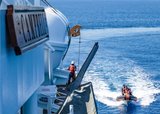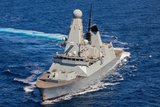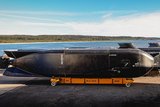New Zealand selects Sea Ceptor for ANZAC Frigate upgrade
MBDA’s Sea Ceptor has been selected by the New Zealand Ministry of Defence (MoD) as the Local Area Air Defence (LAAD) system for the Royal New Zealand Navy’s (RNZN) ANZAC Frigate Systems Upgrade (FSU) project. The selection, announced 7 October, is pending final approval by the New Zealand government to proceed.
Sea Ceptor will equip frigates HMNZ Te Kaha and Te Mana with the naval air defence system capable of protecting not only the host ship but also combined joint allied forces in the vicinity.
The New Zealand MoD released tenders earlier in 2013 for upgrades to systems on the ANZAC Frigates, including sensors, Combat Management System, Anti Ship Missile Defense (ASMD) soft kill, torpedo self defence and the Local Area Air Defence System (LAAD). MBDA’s Sea Ceptor Self and Local Area Air Defence System was included in the Request for Tender for the Combat System integrator.
Des Ashton, New Zealand MoD Deputy Secretary of Defence (Acquisition), said: ‘The primary objective of the ANZAC FSU project is to restore the ship’s combat capability and utility to a comparative level to that of a current generation, new release Combat System. This is required to counter the combined challenges of an increased level of threat sophistication coupled with obsolescence of some of the current systems. We also want to leverage off advances in technology over the past 20 years and incorporate additional functionality and performance through the selection of modern Combat System elements.
‘The LAAD Sea Ceptor system is a key component of the overall project ensuring that crucial constituents of the RNZN fleet are best equipped to respond to the emerging threats and protect not only the frigates themselves but also high value units in company.’
Steve Wadey, managing director MBDA UK, said: ‘I am delighted that New Zealand has selected Sea Ceptor. The New Zealand government’s procurement of Sea Ceptor for the ANZAC FSU project will be the first export success for this highly capable weapon system and proof that MBDA is able to meet such challenging requirements. This success has been supported by the UK government during discussions with the New Zealand MoD, a cooperation that will continue through the life of the project.’
As an active radar system, Sea Ceptor does not require the dedicated tracker/illuminator radars on which semi-active systems depend. Sea Ceptor deploys the Common Anti-Air Modular Missile (CAMM) which, due to its soft launch technology, requires no efflux management system. This minimises the system’s mass and footprint thereby allowing for greater flexibility regarding ship installation positions. CAMM missile canisters are compatible with a wide range of vertical launch systems.
In September it was announced that the British Royal Navy would equip its Type 23 frigates, and later its Type 26 frigates, with the Sea Ceptor system to replace the current Seawolf missile system.
More from Naval Warfare
-
![US Coast Guard prepares procurement of next-gen surface search radar]()
US Coast Guard prepares procurement of next-gen surface search radar
The NXSSR will replace five in-service capabilities and be the US Coast Guard’s primary collision avoidance system.
-
![MBDA-led DragonFire’s latest trials move the LDEW system closer to UK Navy integration]()
MBDA-led DragonFire’s latest trials move the LDEW system closer to UK Navy integration
The DragonFire lines up with other European laser-directed energy weapons being developed in collaboration with MBDA.
-
![Canadian Coast Guard’s OOSV delivery is “major milestone” in fleet modernisation]()
Canadian Coast Guard’s OOSV delivery is “major milestone” in fleet modernisation
The Polar Class 6 platform is the largest CCG science-dedicated vessel and will operate on the country’s east coast.
-
![How the Anduril-HHI autonomous ship plan fits in with the US Navy’s MASC programme]()
How the Anduril-HHI autonomous ship plan fits in with the US Navy’s MASC programme
The new modular vessel is expected to be developed for both commercial and defence use, with a heavy focus on production speed and mission flexibility.






















